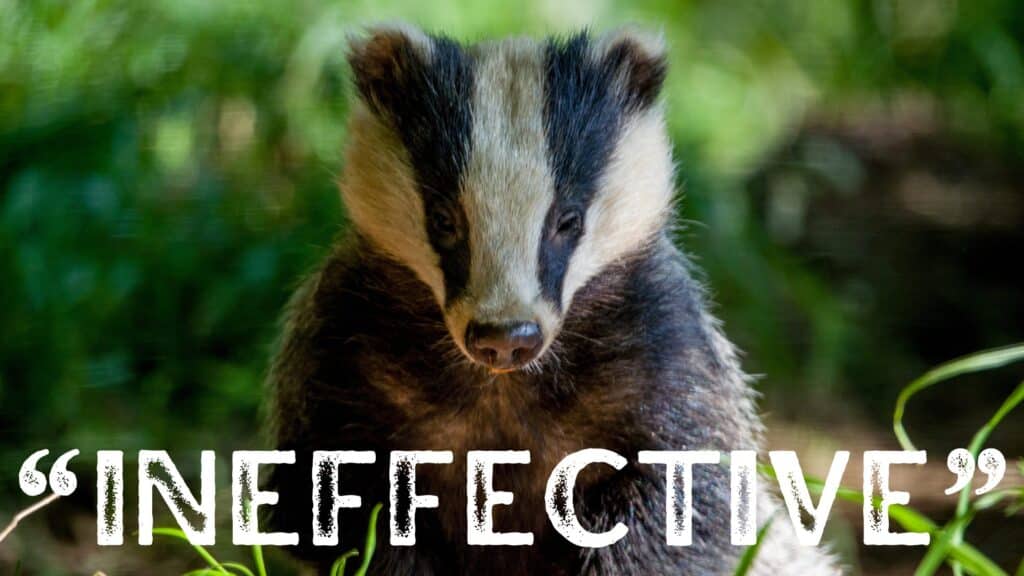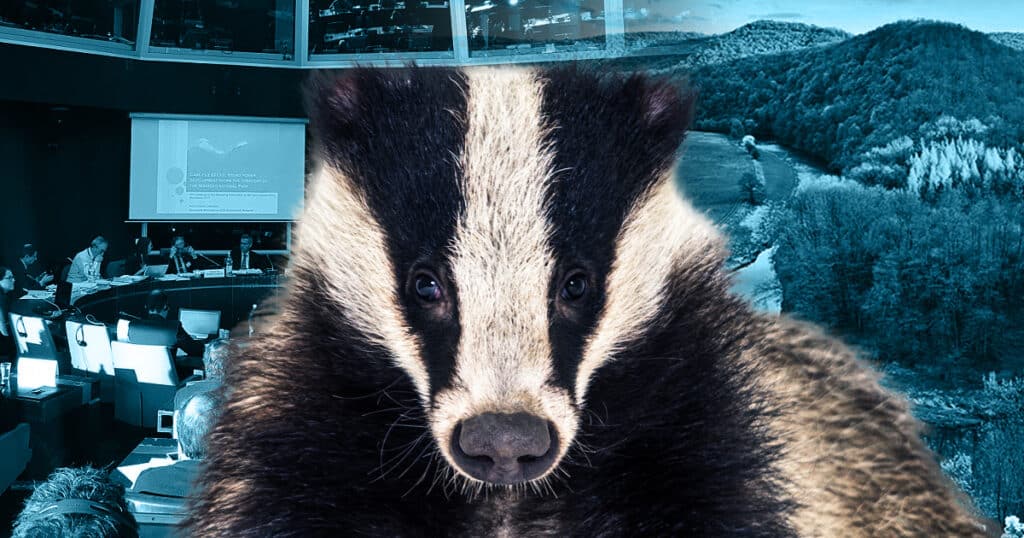The Bern Convention celebrated its 45th anniversary on 19 September. This treaty broke new ground when countries began signing it back in 1979, as it was the first international agreement to protect both wild species and their habitats.
Through the years, Bern has proved instrumental in delivering protections to wildlife. It has also rolled out some commendable initiatives. These include establishing a network of ecological areas across over a dozen countries, known as the Emerald Network. But like all conventions, Bern must also be measured by its ability to enforce treaty provisions and take action when its parties fail to live up to their commitments. On this, the convention falls down, as the sorry tale of England’s badgers shows.
What is the Bern Convention?
The Bern Convention is a treaty that came into force in 1982, with an aim to conserve wildlife and natural habitats in the European region. The treaty currently has 50 parties, including the EU and all its member states, along with non-EU countries such as the UK and Switzerland. Some African nations are also parties to the convention. Bern has four strings to its bow, as it were. These are to take action to protect biodiversity; preserve habitats; respond to environmental challenges; and give people a say in the protection of natural heritage.
At its core, the Bern Convention aims to protect biodiversity through listing wild species of plants and animals in different Appendices and prohibiting exploitation of the groups to varying degrees. Appendix I covers wild plant species and Appendix II lists the wild animals that are ‘strictly protected’ under the convention. Appendix III is for ‘protected’ wild animals for whom some regulated exploitation may be permitted.
Hundreds of thousands of ‘protected’ badgers killed
The Bern Convention lists the European badger as an Appendix III species. This means that although some level of exploitation can be permitted, countries must ensure that they do not endanger or ‘seriously disturb’ populations of the species, including on a local level.
These provisions come with exceptions. Countries may deviate from the rules in certain circumstances, such as to protect farmed animals from “serious damage.” Still, these exceptions are only permissible in the event “that there is no other satisfactory solution and that the exception will not be detrimental to the survival of the population concerned.”
To say that England’s badgers – who are also protected in national law – have been seriously disturbed over the last decade feels like an understatement. In 2013, the Conservative government rolled out a badger cull policy on the hotly contested grounds that it was necessary to protect cows from bovine tuberculosis (bTB). Consecutive Conservative governments have since continued the policy, leading to the killing of over 230,000 badgers by the end of 2023. More culling is currently underway.
The Labour government, which was elected in July, appears intent on leaving the door open for continued culling right up to the next election in 2029. This is despite the fact that the Labour Party branded the cull “ineffective” in its manifesto.

The world’s most responsive nature convention
Labour’s manifesto admission is not news to anyone. The badger cull policy has been controversial since its inception, with scientists, veterinarians, reports, and studies, regularly criticising it for being ineffective and inhumane. Amid these objections and an ever-increasing badger body count, three organisations – Born Free, the Badger Trust, and Eurogroup for Animals – submitted a complaint to the Bern Convention in 2019. They argued that the policy “not only negatively impacts the European badger species, but it fails to effectively tackle the disease of bTB for cattle farmers who are supposed to benefit from it.”
Five years later, and the organisations are still waiting for the Bern Convention to take any action that helps England’s badgers. The issue has been discussed in the convention across the intervening years and many a report has been submitted by both the complainants and the UK government on the matter. But in terms of action that safeguards badgers, there has been none, with the case currently on ‘stand-by’.
This example stands in stark contrast how Bern’s insiders apparently view the convention. Speaking on its 45th anniversary, chair of the convention’s Standing Committee, Estonia’s Merike Linnamägi, said the treaty “is unique in its ability to raise to new challenges.” Linnamägi went on to add that the Standing Committee, which is the convention’s governing body, meets every year and as such, “challenges can be dealt with quickly and recommendations adopted within the year.” Linnamägi concluded:
No other Nature Conservation Convention is so responsive to the challenges we face currently in the Global Biodiversity Crisis.
An immediate moratorium is needed
Responding to Linnamägi’s comments, Born Free told Protect the Wild that the organisation and its partners “have provided the Convention with extensive evidence over the past five years demonstrating that the impact of badger culling on bovine TB in cattle is at best uncertain.” The group submitted its latest evidence in July, which included the fact that the body responsible for issuing cull licences, Natural England, approved culls in May against the advice of its own Director of Science.
In its comments to Protect the Wild, Born Free also pointed to the high cost for badgers of the convention’s inaction to date. It said that since the initial complaint was submitted in 2019, over 160,000 of them have been killed and “tens of thousands more badgers are in danger of being targeted over the coming years.” The organisation added:
“we firmly believe that by continuing to issue licences, the UK government is in beach of the Convention. At the very least, the Convention should urge the UK government to place an immediate moratorium on any further culls to allow new and emerging evidence to be properly considered.”
Carnivores under threat
In other instances, the Bern Convention has clearly been beneficial to wildlife conservation in the European region. For example, the treaty has ensured that countries offer better protections to large carnivores on the continent. This is a success story, with populations of wolves, bears, and Eurasian lynx all seeing relative comebacks.
But this progress is now under threat for some large carnivores, the wolf in particular. Wolves are a ‘strictly protected’ species, i.e. an Appendix II species, under the Bern Convention. This means that no deliberate disturbance, capture, or killing of wolves is permissible. Again, there are exceptions to these rules, such as to protect farmed animals from ‘serious damage’, as outlined above.
Despite the wolf’s strictly protected status, however, some parties to the Bern Convention are utilising exemptions to allow the culling and hunting of wolves at ever-increasing levels. Oftentimes, the parties concerned argue that the killing is necessary to protect farmed animals from wolves. However, predation of farmed animals, such as sheep, is statistically low on an EU-wide scale. An European Commission (EC) report on wolves highlighted, for instance, predation impacts 0.065% of the bloc’s 60 million sheep annually.
Most alarmingly, the EC, which is the executive body of the EU, is recommending that the bloc push for the wolf to be downlisted to an Appendix III species under the Bern Convention. If the EU decides to follow the EC’s recommendation, the wolf would almost certainly be downgraded to Appendix III due to the bloc’s voting power in the convention.
Don’t reverse conservation progress
An EU decision on whether to approve the EC’s proposal is imminent. Hundreds of thousands of European citizens have called on member states to reject the idea. On 19 September, over 300 civil society organisations also called on EU countries not to “reverse conservation progress” and instead maintain the wolf’s existing protection status. They argued that though the species has made a “remarkable comeback” due to the legal protections it enjoys, “at present, there is no scientific basis to support an EU-wide modification of the existing legislation.”
This is because the conservation status of the wolf varies from country to country and therefore the species’ recovery is ongoing. As such, the objectives of the Bern Convention and associated EU legislation have not yet been met, the organisations said.
In short, whether it’s in relation to Britain’s largest remaining land carnivore – the badger – or Europe’s comeback large carnivores like the wolf, the Bern Convention and its parties cannot yet say they are adequately or urgently responding to the needs of these species, or indeed fully rising to the challenge of the biodiversity crisis.
Image via Andy Morffew / Wikimedia, cropped to 2240×1260, licensed under CC BY 2.0

